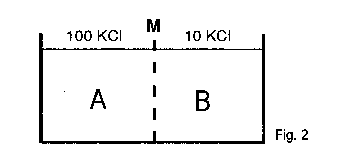
This tutorial exercise considers diffusion, concentration gradients and equilibrium conditions in cells. The aim is to show how selective diffusion of particular ions can generate differences in electrical potential on either side of a membrane (membrane potentials). The direction and magnitude of the membrane potentials depend on which ions are allowed to diffuse.
Note: Don't worry about the exact meaning of concentration units. They simply tell us how much of a substance is present in a particular volume. If we add 10 mmols of KCl (about 0.75gm) to 1 litre of water, the solution has a concentration of 10 mmol per litre. The important thing is that if there is a difference in concentrations between 2 areas a (concentration) gradient exists between the areas. If the 2 areas are separated by a barrier (e.g. a membrane), substances will move only if the barrier lets them - i.e. if the barrier is permeable to the substance. Diffusion will occur from an area of high concentration to an area of low concentration until the concentrations are equal everywhere (this is equilibrium).
Most of the substances you will encounter (e.g. NaCl, KCl) split up (dissociate) in solution into their component ions. Thus the 1 litre solution of l0 mmols KCl will in effect contain l0 mmols of potassium ions (K+) and 10 mmols of chloride ions (Cl-).
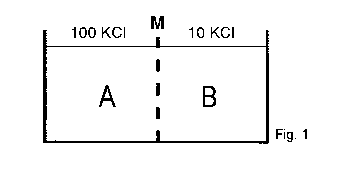
Figure 1 shows a system in which two different solutions of KCl
(all concentrations in mmol./l) are separated by a membrane (M)
that is permeable to both K- and Cl-.
What ionic movements will occur when diffusion is allowed to take place?
Will an equilibrium be reached?
Check answer 1.

In Figure 2 the situation is modified so that the membrane is
permeable only to K+.
What happens now when diffusion occurs?
Check answer 2.
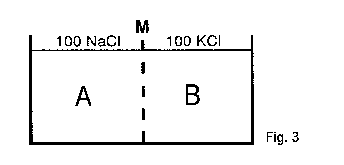
Now the solutions on each side of the membrane are different.
(Figure 3).
The membrane is permeable to K+ and Cl-,
but impermeable to Na+.
What happens now when diffusion occurs?
Check answer 3.
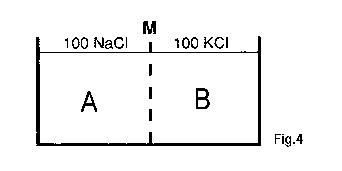
In Figure 4 the solutions are the same as in Figure 3.
The membrane is permeable to K+ and Cl-
as before, but now it is also slightly permeable to Na+
.
What will happen in this situation?
Check answer 4.
What new feature would have to be added to the system shown in
Figure 4 in order to maintain the membrane potential and the ionic
concentration gradients?
Check answer 5.
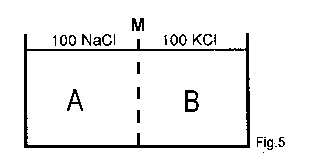
In Figure 5 the membrane permeability is altered so that it is
now only permeable to Na+, and impermeable to K+
and Cl-.
What will happen in this situation?
Check answer 6.